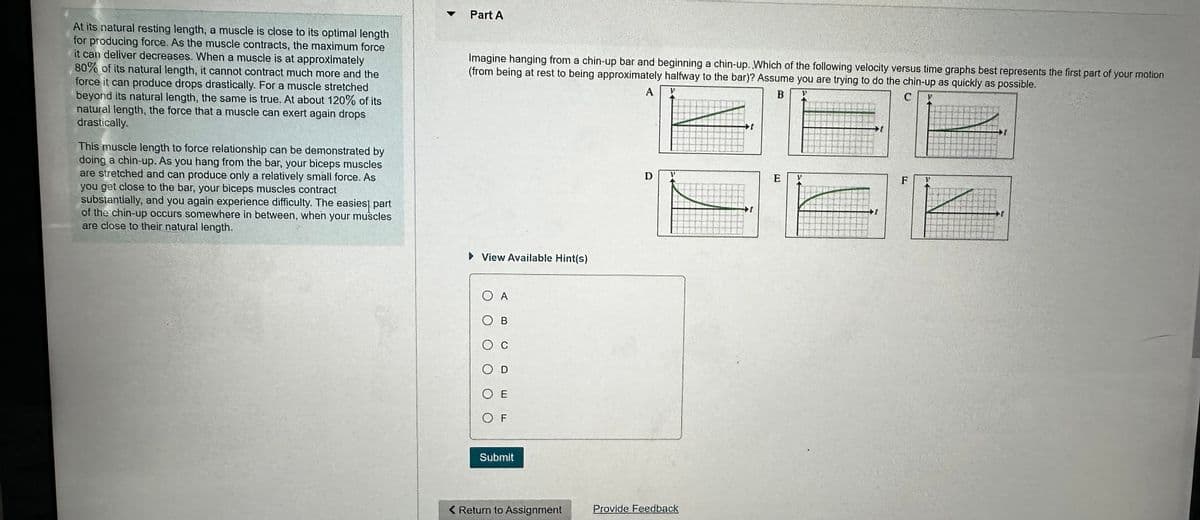At its natural resting length, a muscle is close to its optimal length for producing force. As the muscle contracts, the maximum force it can deliver decreases. When a muscle is at approximately 80% of its natural length, it cannot contract much more and the force it can produce drops drastically. For a muscle stretched beyond its natural length, the same is true. At about 120% of its natural length, the force that a muscle can exert again drops drastically. This muscle length to force relationship can be demonstrated by doing a chin-up. As you hang from the bar, your biceps muscles are stretched and can produce only a relatively small force. As you get close to the bar, your biceps muscles contract substantially, and you again experience difficulty. The easies part of the chin-up occurs somewhere in between, when your muscles are close to their natural length. Part A Imagine hanging from a chin-up bar and beginning a chin-up. Which of the following velocity versus time graphs best represents the first part of your motion (from being at rest to being approximately halfway to the bar)? Assume you are trying to do the chin-up as quickly as possible. A D P 14 B E 14 C F " +1 +1 ▸ View Available Hint(s) О А О в О ○ E OF Submit < Return to Assignment Provide Feedback
At its natural resting length, a muscle is close to its optimal length for producing force. As the muscle contracts, the maximum force it can deliver decreases. When a muscle is at approximately 80% of its natural length, it cannot contract much more and the force it can produce drops drastically. For a muscle stretched beyond its natural length, the same is true. At about 120% of its natural length, the force that a muscle can exert again drops drastically. This muscle length to force relationship can be demonstrated by doing a chin-up. As you hang from the bar, your biceps muscles are stretched and can produce only a relatively small force. As you get close to the bar, your biceps muscles contract substantially, and you again experience difficulty. The easies part of the chin-up occurs somewhere in between, when your muscles are close to their natural length. Part A Imagine hanging from a chin-up bar and beginning a chin-up. Which of the following velocity versus time graphs best represents the first part of your motion (from being at rest to being approximately halfway to the bar)? Assume you are trying to do the chin-up as quickly as possible. A D P 14 B E 14 C F " +1 +1 ▸ View Available Hint(s) О А О в О ○ E OF Submit < Return to Assignment Provide Feedback
University Physics Volume 1
18th Edition
ISBN:9781938168277
Author:William Moebs, Samuel J. Ling, Jeff Sanny
Publisher:William Moebs, Samuel J. Ling, Jeff Sanny
Chapter12: Static Equilibrium And Elasticity
Section: Chapter Questions
Problem 15CQ: A thin wire strung between two nails in the wall is used to support a large picture. Is the wire...
Related questions
Question
Hello please help with physics q

Transcribed Image Text:At its natural resting length, a muscle is close to its optimal length
for producing force. As the muscle contracts, the maximum force
it can deliver decreases. When a muscle is at approximately
80% of its natural length, it cannot contract much more and the
force it can produce drops drastically. For a muscle stretched
beyond its natural length, the same is true. At about 120% of its
natural length, the force that a muscle can exert again drops
drastically.
This muscle length to force relationship can be demonstrated by
doing a chin-up. As you hang from the bar, your biceps muscles
are stretched and can produce only a relatively small force. As
you get close to the bar, your biceps muscles contract
substantially, and you again experience difficulty. The easies part
of the chin-up occurs somewhere in between, when your muscles
are close to their natural length.
Part A
Imagine hanging from a chin-up bar and beginning a chin-up. Which of the following velocity versus time graphs best represents the first part of your motion
(from being at rest to being approximately halfway to the bar)? Assume you are trying to do the chin-up as quickly as possible.
A
D
P
14
B
E
14
C
F
"
+1
+1
▸ View Available Hint(s)
О А
О в
О
○ E
OF
Submit
< Return to Assignment
Provide Feedback
Expert Solution
This question has been solved!
Explore an expertly crafted, step-by-step solution for a thorough understanding of key concepts.
Step by step
Solved in 1 steps

Recommended textbooks for you

University Physics Volume 1
Physics
ISBN:
9781938168277
Author:
William Moebs, Samuel J. Ling, Jeff Sanny
Publisher:
OpenStax - Rice University

University Physics Volume 1
Physics
ISBN:
9781938168277
Author:
William Moebs, Samuel J. Ling, Jeff Sanny
Publisher:
OpenStax - Rice University